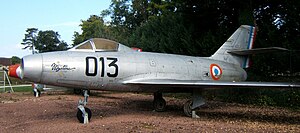Loading AI tools
Fighter-bomber in the French Air Force From Wikipedia, the free encyclopedia
The Dassault MD.452 Mystère is a 1950s French fighter-bomber. It was a straightforward development of the successful Dassault Ouragan
This article includes a list of references, related reading, or external links, but its sources remain unclear because it lacks inline citations. (June 2011) |
| MD.452 Mystère | |
|---|---|
 | |
| General information | |
| Type | Fighter-bomber |
| National origin | France |
| Manufacturer | Dassault Aviation |
| Primary user | French Air Force |
| Number built | 171 |
| History | |
| Manufactured | 1951–1957 |
| Introduction date | 1954 |
| First flight | 23 February 1951 |
| Retired | 1963 (France) |
| Developed into | Dassault Mystère IV |
After the success of the Ouragan, Dassault was working on a more advanced machine which would take to the air in early 1951 as the MD.452 Mystère I.
The first prototype Mystère I was essentially an Ouragan with a 30-degree swept wing and modified tail surfaces. Two further prototypes followed, powered by the Rolls-Royce Tay 250 centrifugal-flow turbojet, an improved version of the Rolls-Royce Nene, built under licence by Hispano-Suiza, and rated at 28.0 kN (6,300 lbf) thrust.
These three Mystère I prototypes led to two Mystère IIA prototypes, powered by the Tay and armed with four 20 mm (0.787 in) Hispano cannon; and then four Mystère IIB prototypes, which traded the four 20 mm (0.787 in) cannon for two 30 mm (1.181 in) DEFA revolver-type cannon. A Mystère IIA was the first French aircraft to break Mach 1 in controlled flight (in a dive), on 28 October 1951.
The eleven preproduction machines that followed were designated Mystère IIC, nine of which were fitted with the SNECMA Atar 101C axial-flow turbojet, rated at 24.5 kN (5,500 lbf) thrust, while two were experimentally fitted with the afterburning Atar 101F, with an afterburning thrust of 37.3 kN (8,400 lbf).
The French Air Force ordered 150 Mystère IICs, with the first production machine flying in June 1954, being delivered in October of that year. The production aircraft featured the twin 30 mm (1.181 in) DEFA cannon, an Atar 101D turbojet with 29.4 kN (6,600 lbf) thrust, increased tail sweep, and revised intake trunking and internal fuel tank arrangement. Top speed was 1,030 km/h (560 kn; 640 mph) at low level. Details of external stores are unclear, but a reasonable assumption would be that they were similar to those of the Ouragan.
The last Mystère IIC was delivered in 1957, by which time the type was already being relegated to advanced training duties. Aircraft design was moving very quickly in the 1950s and even as the Mystère IIC was becoming operational, the better Dassault Mystère IVA was flying. The Mystère IIC was very much an interim type, though it did persist in the training role until 1963.
There were no foreign buyers for the Mystère II. As noted, the Israelis wanted to buy 24 but changed their minds and bought Mystère IVAs instead. It appears that the Mystère II was never used in combat.


Data from The Complete Book of FightersGreen, William; Gordon Swanborough (1997). The Complete Book of Fighters. London: Salamander Books Limited. p. 148. ISBN 1-85833-777-1. and "Dassault MD.452 Mystere Single-Seat, Single-Engine Fighter / Fighter-Bomber Aircraft". www.militaryfactory.com. Retrieved 16 June 2024.
General characteristics
Performance
Armament
2 x 30mm DEFA internal cannons
Related development
Aircraft of comparable role, configuration, and era
Related lists
Seamless Wikipedia browsing. On steroids.
Every time you click a link to Wikipedia, Wiktionary or Wikiquote in your browser's search results, it will show the modern Wikiwand interface.
Wikiwand extension is a five stars, simple, with minimum permission required to keep your browsing private, safe and transparent.